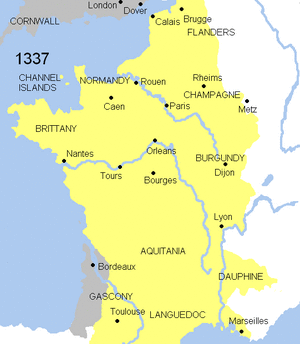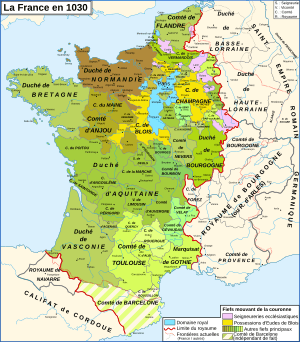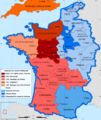Duchy of Aquitaine facts for kids
Quick facts for kids
Duchy of Aquitaine
|
|||||||||||||||
|---|---|---|---|---|---|---|---|---|---|---|---|---|---|---|---|
| 602–1453 | |||||||||||||||
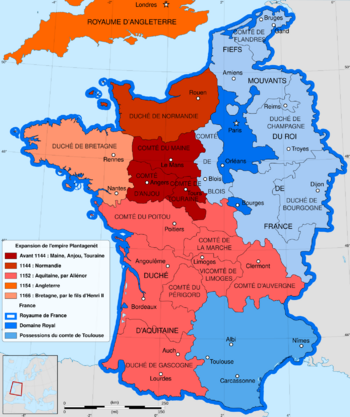
Map of France in 1154
|
|||||||||||||||
| Status | Fief of Francia (602 – late 7th century), independent duchy (intermittently late 7th century – 769) | ||||||||||||||
| Common languages | Medieval Latin Old Occitan |
||||||||||||||
| Religion | Christianity | ||||||||||||||
| Government | Feudal monarchy | ||||||||||||||
| Duke of Aquitaine | |||||||||||||||
|
• 860–866
|
Ranulf I of Aquitaine | ||||||||||||||
|
• 1058–1086
|
William VIII of Aquitaine | ||||||||||||||
|
• 1126–1137
|
William X of Aquitaine | ||||||||||||||
| Historical era | Middle Ages | ||||||||||||||
|
• Duke appointed by the Merovingian kings
|
602 | ||||||||||||||
|
• Annexed by Kingdom of France
|
1453 | ||||||||||||||
|
|||||||||||||||
| Today part of | France | ||||||||||||||
The Duchy of Aquitaine (also known as Ducat d'Aquitània in Occitan and Duché d'Aquitaine in French) was a powerful historical area in what is now France. It was a "fiefdom," which means it was a territory held by a duke who owed loyalty to a king or emperor. Its size and even its name changed a lot over hundreds of years. Sometimes, it covered a large part of southwestern and central France.
Aquitaine started in the 7th century as a duchy under the Frankish kingdom. It was a bit like a recreated Roman province. For a while, it became an independent duchy. Later, it was absorbed into the Carolingian Empire and then into West Francia. In 1153, Aquitaine became linked to the Angevin kings of England through marriage. This led to a big rivalry between the French and English kings over who controlled these lands. By the mid-1200s, only a small part, Gascony, remained under English control. The Hundred Years' War (1337-1453) finally saw France take full control of Aquitaine in the 1450s. Much of its land then became part of the French king's direct territory.
Contents
History of Aquitaine
Early Beginnings
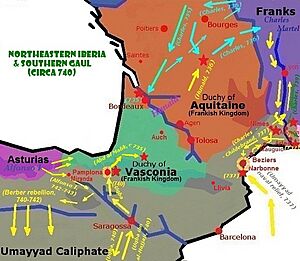
The region of Aquitaine was first ruled by the Visigoths in the 400s. Then, in 507, the Franks led by Clovis I conquered it. For a long time, it was directly controlled by Frankish kings. In 629, King Dagobert I gave a southern part of Aquitaine to his younger brother, Charibert II. This area became the basis for the later Duchy of Aquitaine. Charibert fought successfully against the Basques, but after he died, they rebelled again.
The Duchy of Aquitaine became almost independent within the Frankish empire in the late 600s. The first known duke was Felix, who ruled around 660. His successor, Lupus, also ruled quite independently. Then, Odo the Great became duke in 700. He made a peace treaty with Charles Martel, a powerful Frankish leader. Odo famously defeated the Moors (Muslim invaders from Spain) in the Battle of Toulouse in 721.
However, Charles Martel wanted control of Aquitaine. In 731, he attacked and looted parts of the duchy. Odo fought back but was weakened. Soon after, in 732, the Moors attacked again, defeating Odo twice. Odo had no choice but to ask Charles Martel for help and promise loyalty to him.
Odo's son, Hunald, took over and tried to regain independence, defying Charles Martel. Charles attacked Hunald and his allies. Eventually, Hunald gave up and left the fight to Waifer (also called Guaifer). After the Franks conquered Septimania in 759, King Pepin turned his attention to Aquitaine. This led to an eight-year war. Waifer fought hard but was killed in 768. This ended Aquitaine's independence. During these wars, many cities, businesses, and cultural centers in Aquitaine were destroyed.
In Aquitaine, like in the old Roman and Visigothic areas, women had more rights than in other parts of Europe. Laws allowed women to inherit land and titles. They could manage their property on their own, even if they were married. They could also write wills and represent themselves in court from age 14. By age 20, they could arrange their own marriages. This meant that for noble families, the eldest son usually inherited, but daughters could also inherit if there were no sons.
Carolingian Kingdom
After the Franks conquered Aquitaine in 769, the duchy as it was before stopped existing. To prevent future rebellions, Charlemagne decided to organize the land differently. In 781, he made his three-year-old son, Louis, king of Aquitaine. This new Carolingian Kingdom of Aquitaine was under the main Carolingian king or emperor. It included not only Aquitaine but also Gascony and parts of Spain.
When Louis became emperor in 814, he gave Aquitaine to his son, Pepin I. After Pepin I died in 838, the nobles of Aquitaine chose his son, Pepin II of Aquitaine, as their king. However, Emperor Louis I disagreed and gave the kingdom to his youngest son, Charles (later known as Charles the Bald). This caused confusion and conflict. Eventually, Charles won control. Pepin II was imprisoned in 852, and Charles the Bald made his own son, also named Charles, the ruler of Aquitaine. When the younger Charles died in 866, his brother Louis the Stammerer took over. In 877, when Louis became King of the Franks, Aquitaine became fully part of the Frankish kingdom.
However, the title of Duke of Aquitaine reappeared. It was held by Rainulf I of Aquitaine, Count of Poitiers. This new Duchy of Aquitaine included areas like Poitou and Saintonge. Rainulf's family kept the title until 893, when Rainulf II was poisoned. King Charles III then gave the duchy to William the Pious, Count of Auvergne. William was famous for founding the abbey of Cluny. His nephew, William II, became duke in 918.
Many dukes followed. One of them, William V, known as "the Great," greatly increased his power and territory. His duchy almost reached the size of the old Roman Aquitaine, but it didn't go south of the Garonne River, which was controlled by the Gascons. William V died in 1030. His successor, Odo (died 1039), added Gascony to Aquitaine.
Angevin Empire
By the late 1000s, the Ramnulfid family was very powerful in southwestern France. Through marriage, their lands became part of the "Angevin Empire" under the English crown by 1153.
William IX, Duke of Aquitaine (died 1127) became duke in 1087. He was known as a crusader and a poet. His granddaughter, Eleanor of Aquitaine, became Duchess of Aquitaine at age 15. She was the eldest daughter and heir of William X (died 1137), as his son had died young. Three months after her father's death, Eleanor married Louis, who was next in line for the French throne. Louis's father quickly arranged the marriage because he didn't want such a large territory to be ruled by a young girl. When Louis VI died, and Eleanor's husband became King Louis VII, the Duchy of Aquitaine officially came under the French Crown. For 15 years, Louis VII controlled lands that were as big as those of the English king.
However, Eleanor's marriage to Louis was later ended in 1152. She kept her lands and title as Duchess of Aquitaine. Soon after, in May 1152, she married Henry, Duke of Normandy. Henry was a claimant to the English throne. When he defeated King Stephen in 1153 and became King Henry II of England, Aquitaine became part of the English crown.
After putting down a rebellion in Aquitaine, Henry gave the duchy to his son, Richard. When Richard died in 1199, it went back to Eleanor. When she died in 1204, her son John inherited it, and it became a permanent part of the English crown. From then on, the duchy's fate was tied to other English lands in France, like Normandy. This eventually led to the Hundred Years' War between England and France.
Aquitaine, as it came to the English kings, stretched from the Loire River to the Pyrenees mountains. However, its southeastern border was limited by the large lands of the Counts of Toulouse. The name "Guienne," a changed form of Aquitaine, started being used around the 10th century. The later history of Aquitaine is often combined with the history of Gascony and Guienne.
Hundred Years' War
In 1337, King Philip VI of France took back the fief of Aquitaine (which was mostly Gascony) from Edward III of England. Edward was a descendant of Eleanor of Aquitaine. In response, Edward claimed the entire Kingdom of France for himself, as he was the grandson of King Philip IV of France. This disagreement started the Hundred Years' War. Both the English Plantagenets and the French House of Valois claimed to be the rightful rulers of Aquitaine.
In 1360, both sides signed the Treaty of Brétigny. Edward gave up his claim to the French crown but remained the sovereign Lord of Aquitaine. However, the treaty was broken in 1369, and the war and claims resumed. In 1362, Edward III made his eldest son, Edward the Black Prince, the Prince of Aquitaine. Later, in 1390, King Richard II appointed his uncle, John of Gaunt, as Duke of Aquitaine. This title passed to John's descendants, who also became kings of England.
Henry V of England ruled Aquitaine as King of England from 1413 to 1422. He invaded France and won important battles like the Battle of Agincourt in 1415. He managed to get the French crown for his family through the Treaty of Troyes in 1420. Henry V died in 1422, and his son Henry VI became king when he was less than a year old. During Henry VI's reign, England gradually lost control of France.
The French kings of the Valois family also claimed control over Aquitaine. They sometimes gave the title of duke to their heirs, the Dauphins. The French victory in the war was completed with the Battle of Castillon in 1453. England and France were technically at war for another 20 years, but England couldn't continue fighting because of its own internal conflicts, the Wars of the Roses. The Hundred Years' War officially ended with the Treaty of Picquigny in 1475. After the war, Aquitaine returned to the direct rule of the King of France. The title "Duke of Aquitaine" was only given occasionally after that, and it was mostly just a honorary title.
Geography and Areas
Over time, the Duchy of Aquitaine included the Duchy of Gascony and, until 1271, the County of Toulouse. Toulouse is now part of the Occitanie region in France. Most of the duchy after 1271 now forms the Nouvelle-Aquitaine region. Parts of it also extend into other regions like Pays de la Loire and Centre-Val de Loire.
In the Middle Ages, the County of Aquitaine bordered the Pyrenees mountains to the south. To the east, it bordered the County of Toulouse and the Kingdom of Burgundy. To the north, it bordered areas like Brittany and Anjou. By the 1200s, many of these northern areas had become part of the kingdom of France.
Here are some of the main areas that were part of Aquitaine:
- Aquitaine proper
- County of Poitou
- County of La Marche
- County of Angoulême
- County of Périgord
- County of Auvergne (became part of the French royal lands in 1271)
- County of Velay
- County of Saintonge
- Lordship of Déols
- Lordship of Issoudun
- Viscounty of Limousin
- Duchy of Gascony, which was joined with Aquitaine at different times.
- County of Agenais
- County of Toulouse (mostly independent from 778, returned to French royal control in 1271)
- County of Quercy
- County of Rouergue
- County of Rodez
- County of Gevaudan
- Viscounty of Albi
- Marquisat of Gothia
Images for kids
See also





